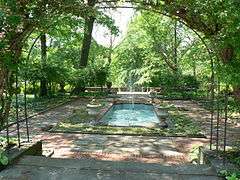Cleveland Cultural Gardens
|
Cleveland Cultural Gardens | |
|
The Hungarian Cultural Garden (1938) is one of 27 nationality gardens in Rockefeller Park National Historic District. | |
  | |
| Location | along both sides of Doan Brook and on both East Blvd and Martin Luther King Jr. Drive. Mainly between Lake Erie and Wade Park Avenue. All but one within Rockefeller Park. |
|---|---|
| Coordinates | 41°31′30″N 81°37′22″W / 41.52500°N 81.62278°WCoordinates: 41°31′30″N 81°37′22″W / 41.52500°N 81.62278°W |
| Built | 1926 through 2011 and still building |
| Architect | Ernest J. Bowditch, et al. |
| Architectural style | Classical Revival, Art Deco, Landscape Architecture |
| NRHP Reference # | 05000382[1] |
| Added to NRHP | 2005 |
The Cleveland Cultural Gardens are a collection of public gardens located in Rockefeller Park in Cleveland, Ohio. The gardens are situated along East Boulevard & Martin Luther King Jr. Drive within the 276 acre of wooded parkland on the city's East Side.[2] In total, there are 31 distinct gardens, each commemorating a different ethnic group whose immigrants have contributed to the heritage of the United States over the centuries, as well as Cleveland.[3]
History
Twenty-seven individual gardens, and growing. Each presents the culture of their respective nation through cultural figures and icons in a variety of materials. Each Garden's landscaping suggests the particular country or nationality for which it is named.[4]
Conceived in 1916 to feature literary figures and then modified as time went on. The first garden, named in honor of William Shakespeare, was British. Leo Weidenthal, a Jew, started a tradition when he planted the first ethnic garden called the Hebrew Garden in 1926.[5] The original purpose was to get nationality groups working with each other and learning more about each other’s culture at a time when most of the nationalities lived in self-imposed ghettos, self-developed to facilitate the transition from immigrant status, with little or no English language skills, to functional Americans.[6]
Highly successful from the start, the project had almost universal political, media and civic support that only grew as time went on. This became critical when the original plan to have each nationality group fund its own Garden ran into the Depression’s economic wall. However, the City came to the project’s rescue by channeling Federal money and manpower (Works Progress Administration) into building thirteen of the original fifteen Gardens, after the first two were finished.[6]
The number of Gardens continue to increase as new immigrant groups to the region fund their own Garden, a source of great pride.
The Gardens
- British Garden (1916)
- Hebrew Garden (1926)
- German Garden (1929)
- Italian Garden (1930)
- Slovak Garden (1932)
- Slovenian Garden (1932)
- Hungarian Garden (1934)
- Polish Garden (1934)
- American Garden (1935)
- Czech Garden (1935)
- American Legion Peace Gardens (1936)
- Lithuanian Garden (1936)
- Irish Garden (1939)
- Rusin Garden (1939)
- Greek Garden (1940)
- Ukrainian Garden (1940)
- Finnish Garden (1958)
- Estonian Garden (1966)
- Romanian Garden (1967)
- African-American Garden (1977)
- Chinese Garden (1985)
- India Garden (2005)
- Latvian Garden (2006)
- Azerbaijan Garden (2008)
- Serbian Garden (2008)
- Croatian Garden (2009)
- Armenian Garden (2010)
- Syrian Garden (2011)
- Albanian Garden (2012)
External links
References
- ↑ "National Register of Historical Places – Ohio(OH), Cuyahoga County". National Register of Historic Places. Nationalregisterofhistoricplaces.com. Retrieved 2011-07-05.
- ↑ Cultural Gardens in Cleveland's Rockefeller Park need - and deserve - TLC | cleveland.com
- ↑ Encyclopedia of Cleveland History:CLEVELAND CULTURAL GARDEN FEDERATION
- ↑ Cleveland Cultural Gardens
- ↑ John H. Russell & Thomas S. Spencer (Jul 28, 2005). Gardens Across America, East of the Mississippi: The American Horticulatural Society's Guide to American Public Gardens and Arboreta. Taylor Trade Publishing. p. 310. Retrieved 2013-05-08.
- 1 2 Their Paths are Peace by Clara Lederer - Cleveland Memory
